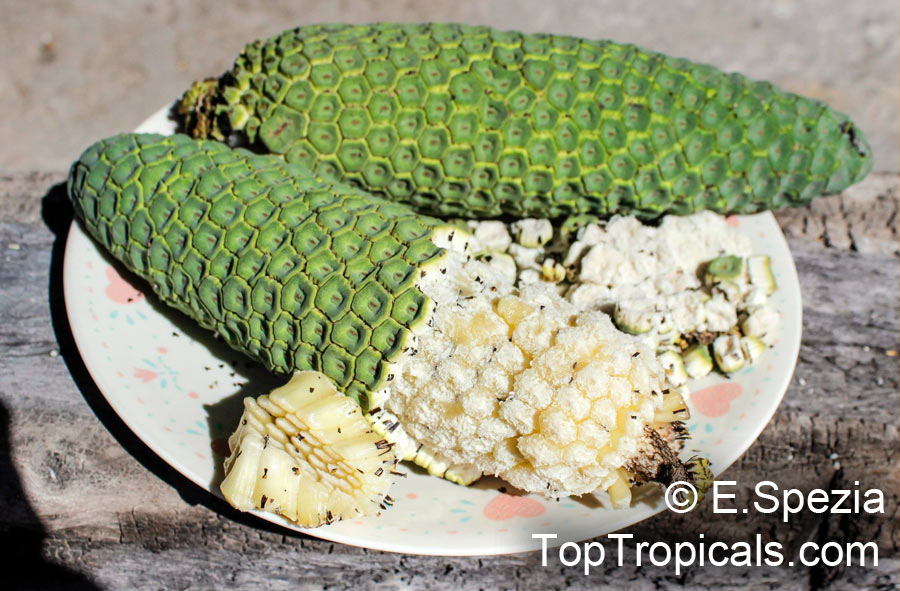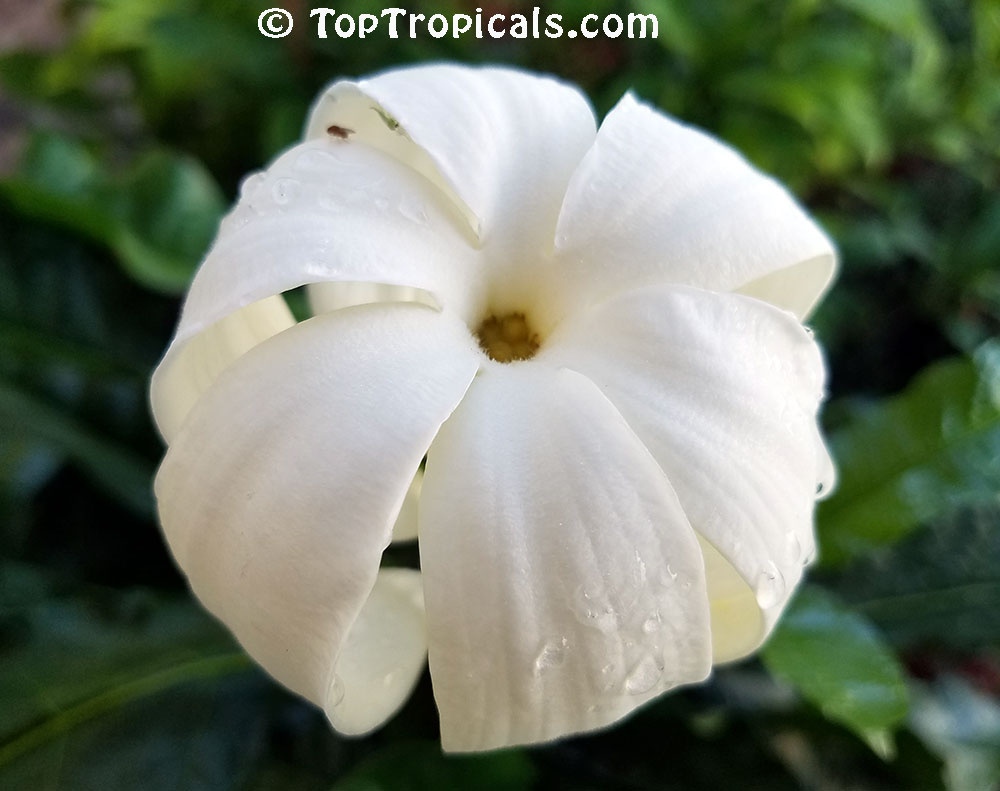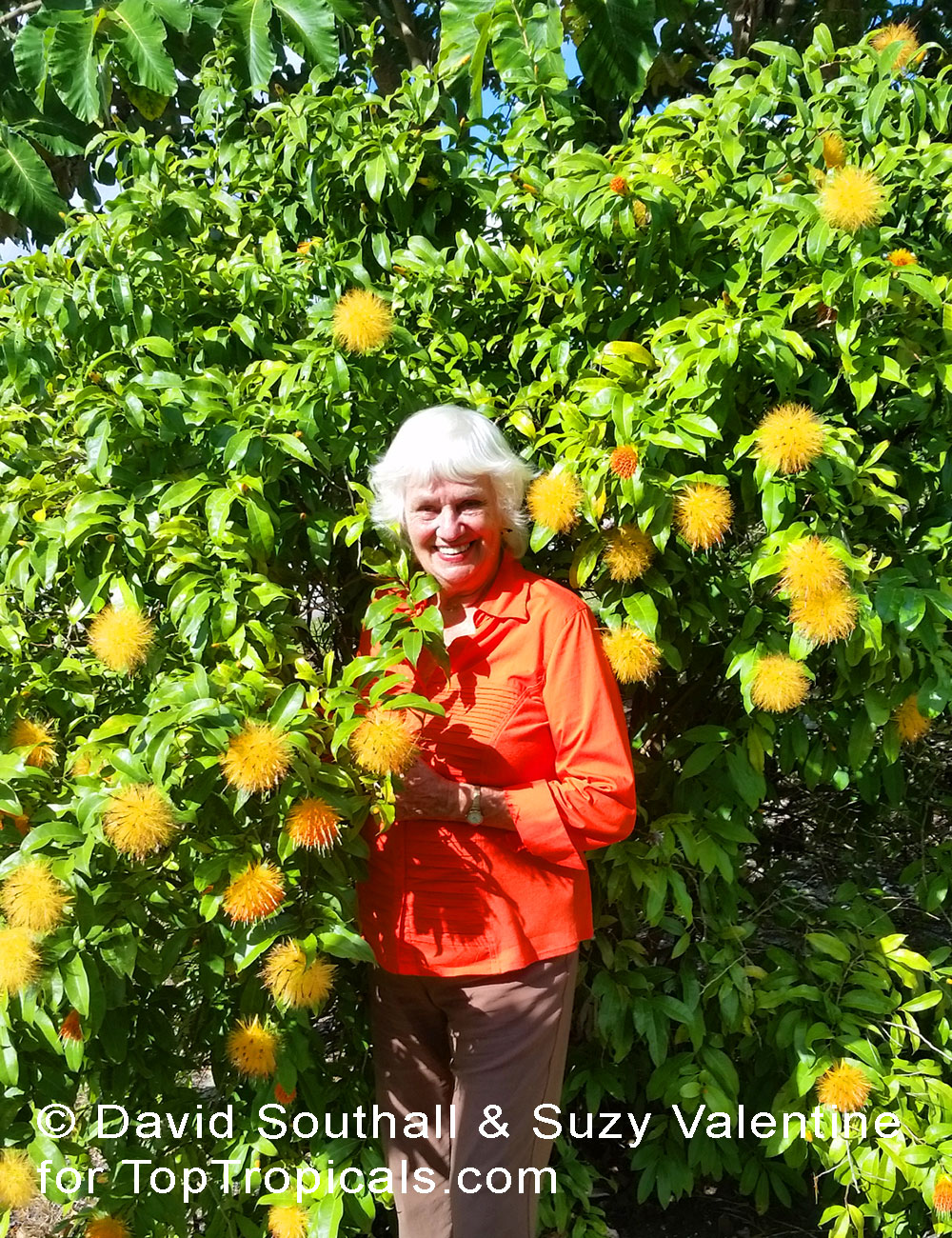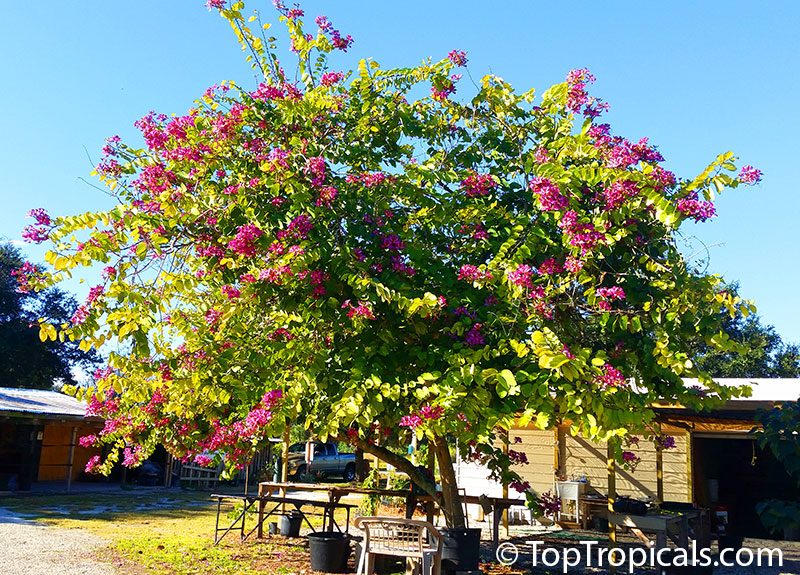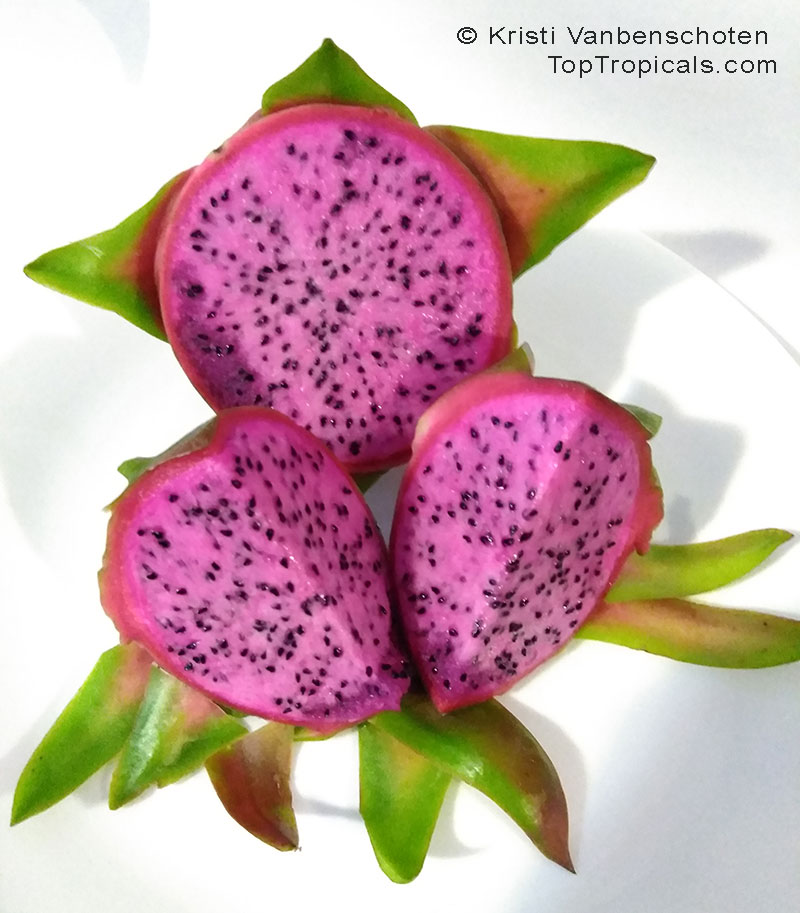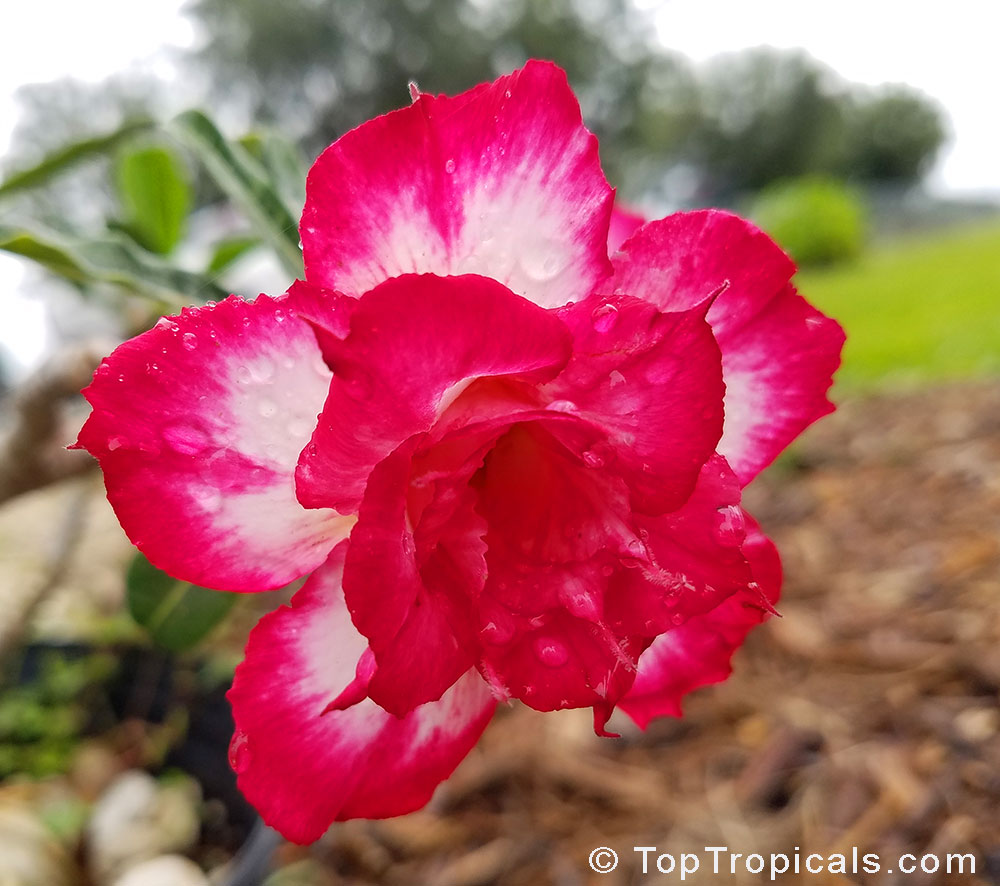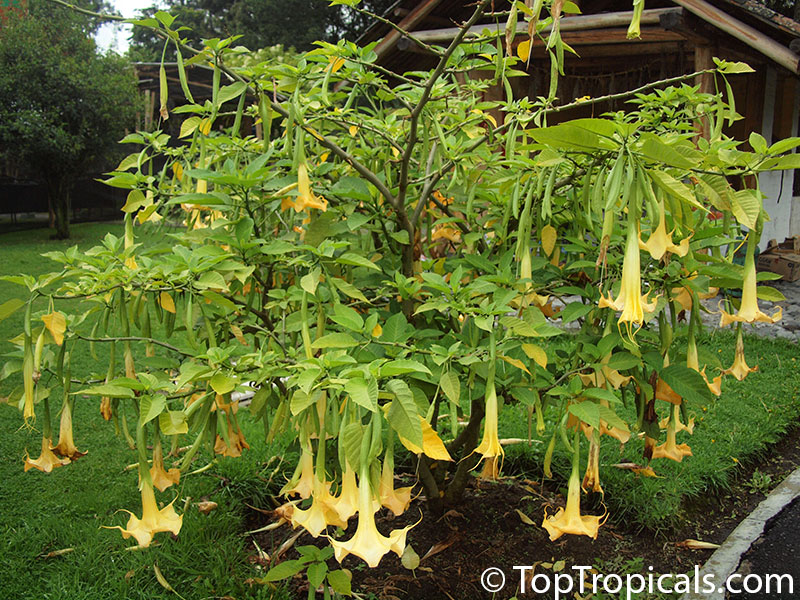Garden Blog - Top Tropicals
Date:
Monstera deliciosa - Swiss cheese plant
Swiss cheese plant is a jungle climbing relative of the philodendron from Mexico and Guatemala. It is seen in gardens in tropical and subtropical areas, growing well in partial sun or shade. The plant begins bearing fruit after three years. The large deep green, cone-like fruit is actually an unripened flower spike, covered with hexagonal scales that dry out and separate as the fruit ripens from the base upwards, revealing the white pulp. It takes a little longer than a year to mature to an edible stage. The fruit tastes kind of like a cross between a sugar apple and a pineapple. Very perfuming smell and taste! It's so amazing, can't figure the consistency, but totally a pineapple sugar apple cross... But wash the black specks off before eating - they will sting your tongue.
Date:
Fragrant garden
Q: I love fragrant plants and I want to make a fragrant garden. Your website offers amazing selection. A friend of mine told me I should be careful with planting fragrant plants next to each other, and that mix of fragrances may create a funny combination. Are there any flowers that don't go together?
A: Flower scents, unlike perfumes, are pure natural and not as intoxicating to create funny combinations. Although some of them can be strong and even overwhelming. Example - Night Blooming Jasmine, Cestrum nocturnum, which fragrance at night is super-sweet; however most people like it. Reality is, even Night Blooming Jasmine planted next to Gardenia won't create a bad mixture, although one scent may somewhat take over another. In any case, with wind blowing in your garden, you will never be disappointed with fragrant garden. Some plants, like Ylang Ylang - Cananga odorata, or Magnolia champaca, create very fine fragrance that can be smelled yards away, other flowers you will need to stick your nose into.
Check out plants for fragrant garden
Date:
Looking for the rarest plant? This is the one!
Stifftia chrysantha - Pompom, Rabo-de-Cutia
Looking for the rarest plant? This is the one!
Stifftia chrysantha is an exotic, rare flowering small tree with
spectacular flowers, endemic to the vast tropical savanna ecoregion of Brazil
called Cerrado. It grows into a bushy, attractive tree between 8 and 15 ft tall
and starts flowering within 1.5 - 2.5 years from seed. It is a very rewarding
plant that blooms 9 months out of the year, starting in Winter with great
intensity during July-September, with each flower staying on the plant for
several weeks. Seeds ripen from September through November.
The tree belongs to Aster family (Compositae) and has nothing to do
with Powderpuffs which are from Bean (Fabaceae) family. The flower has 30 to 40
green, imbricated scales with short hairs, and actinomorphic corollas are
orange below and darker above. After flowering, the inflorescence blows apart,
which would scatter seeds. The dried center remaining is very attractive, like
a small dried flower, and lasts for many months.
Stifftia can be grown in full sun to partial shade and is relatively
cold tolerant, can take short cold spells.
The plant doesn't like wet feet
and heavy/soggy soils; requires very well drained, acidic soil. We strongly
recommend to use our professional soilless mix. Let soil
slightly dry between waterings. It can be grown in full sun to partial shade and is
relatively cold tolerant, can take short cold spells. If grown in a pot, try
to keep the container shaded because roots don't like to be overheated. The
plant needs monthly applications of slow
release fertilizer as well as extra iron - use micro-nutrients to
keep leaves green and healthy.
See more pictures of this beauty.
Date:
How to get shade quickly... and stay away from oaks
Q: I just moved from Tennessee into a new house in Florida and there are no trees on the property, the yard is brutal hot. What can I plant so I have some shade real quick? I like Florida shady oaks, how long will they take to grow?
A: First
of all, do not rush into oak solution. Oaks are beautiful shade trees, however
they have at least 2 problems:
a) Oaks are slow growers and unless you are willing to wait some 20
years... you won't get that desirable shade that quickly.
b) We have hurricanes in Florida... sometimes. A hurricane can damage
any tree, however with oaks it may be the worse case scenario - the branches
of those giant trees are huge, hard and heavy and in unfortunate situation
when you need to remove or trim a broken tree, it may cost you... a few thousand
dollars.
These are solutions that are more economical and practical:
1) Selection. If you have room, get one of these most popular Florida shade trees: Royal Poinciana, Golden Shower, Hong Kong Orchid Tree, Red Kapok, Bottlebrush, and many others. See full list of fast growing shade trees. Or simply get a Mango Tree and have delicious fruit too! Many varieties of Mangos are very large and fast growing.
2) Do it right. Even if you are planting a smaller tree, 1-3 gal
size, it may become a nice shade tree within 2-3 years and start providing
your driveway with desirable shade. The keys for fast growth are -
a) Good soil. Dig as big hole as possible and fill it with good
rich soil containing compost. See planting instructions PDF.
b) Water. Do not rely on sprinklers and rains. Water your tree
daily for the first week, then at least twice a week for another month. After
that, irrigation system will be enough.
c) Fertilizer. Put a few handfuls of fertilizer in a planting hole. Then fertilize once a month during warm
season. Apply micro elements for even better results and faster growth.
3) Ask experts. Contact our office for advice. We will suggest the most suitable shade tree for your yard based on features of your property: location, soil, exposure, etc.
Date:
How to grow a Dragon Fruit
Q: I want to grow a Dragon Fruit. Should I use cuttings or seed? What varieties do you recommend? How difficult it is to grow? How soon does it start flowering and fruiting?
A: Dragon Fruit, or Pitaya is a highly prized, vining, fruit bearing
cactus, extremely unusual terrestrial/epiphytic plant. It has magnificent flowers,
stunningly beautiful fruit with an intense color, curious shape, and a
delicious taste. The night blooming white flowers can be up to 14 inches in
length. The fruit is most often eaten chilled and cut in half so the flesh may be
spooned out. The juice is used in frozen drinks and it is in a new Tropicana
Twister flavor. It is a must have for any collector or gardener with the flair
for the unusual.
It takes 2-3 years for seedlings to fruit, besides the variety pay not
come true to seed. We grow our plants from cuttings that are easy to root.
We offer many selected varieties, most of them self-pollinating. The plants are
ready to flower and fruit this year, or the next year.
Dragon Fruit Cactus is easy to grow, doesn't need much other than strong
support, full sun, well-drained soil - adenium soil mix works great - and fertilizer during hot months, and SUNSHINE-Honey applications for growing sweeter fruit. For larger fruit
bud thinning is recommended.
Date:
Q: I want to order a plant that you have only one left in stock; however the weather is extremely hot in my area right now. Do you have any temperature limitations when you ship your plants?
A: We ship
plants year around and do our best to watch weather forecast at destination.
However the forecast may change to worse within a day or two while a plant
is in transit. To ensure your plants have a safe trip during extreme weather,
follow these steps:
- notify us if you want to wait until weather permitting so we hold
your shipment until further notice;
- make sure to track your package and be at home at time of delivery.
The only time when a plant can get temperature damage, from our experience, is
when the box is left on your doorstep while too hot (or too cold) outside.
- you may use your business as shipping address if no one is home
during regular business hours of delivery.
- unpack the box immediately and follow planting instructions. Keep
plant in shade until recovered; never plant directly from a box into the ground;
never plant into hot, full sun: protect a new plant with a shade cloth for a
few days until established, and water as needed.
- use SUNSHINE booster to help plants recover from shipping stress. It really works! For only $4.95 with FREE
shipping!
On the photo: Adenium is the easiest plant for shipping!
Date:
TROPICAL GARDENING: How to grow Brugmansia (Angel Trumpet) in the ground outside.
Q: I recently moved from New Jersey to Florida and I brought with me my Brugmansia that I used to have as a house plant. Can I plant it in the ground now?
A: Angel Trumpet - Brugmansia - is a very popular container plant
valued for its large, stunning fragrant flowers. Originated from South
America, it will be happy to grow in tropical to subtropical climate outdoors.
These are a few useful tips to get the most out of this beautiful plant:
1) Light. Plant it in full sun - the more sun, the more flowers
you get, although Brugmansias tolerate shade. If the plant was previously
grown in container indoors, to avoid leaf burn, keep it protected with a shade
cloth or simply white sheet for a while and gradually open to adjust to full
sun.
2) Soil and fertilizer. Use fertile soil with lots of organic
matter (add compost to existing soil). It must be very well drained, Angel
Trumpet won't tolerate waterlogged conditions. Plant it on a little "hill"
elevated 3-4" above the surrounding area. Brugmansias are very heavy feeders. Once
the plant is established, fertilize on regular basis with Slow Release Fertilizer - a handful once a
month.
3) Water. Water daily until established. Once the root system is
well developed, the plant is drought tolerant and won't require too much
care. But at the beginning, watch the leaves - the lush foliage droops quickly
if the plant is thirsty.
4) Plan space. Brugmansia is a short tree, but it needs a lot of
room to spread branches with its heavy hanging flowers. Think 12" wide and
maybe almost as much tall.
5) Support. Being widespread plant, Brugmansia can be blown with
strong winds. Stake with strong support until established.
6) Propagation. Brugmansia is one of the few plants that
propagates with semi-woody cuttings; soft green cuttings usually have little
success. Other than that, it is pretty easy!
Check out our Brugmansia collection and... collect them all!
Date:
Fabulous Frangipani - Plumeria
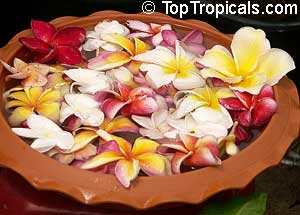
New
article! By Jane Jordan, a horticulturist who
studied and worked at the RHS botanical gardens in
Cannington, England. She now lives in Sarasota, Florida.
Alongside her passion for horticulture, she is also a
novelist.
"...The name Frangipani is derived from a 16th century
Italian Marquess, who invented a plumeria scented perfume.
While in Hawaii they are known as Lei trees. Lei means
garland or wreath, and Lei flower garlands are famously
given as a symbol of affection. Hawaii has become
synonymous with this beautiful flower, although
Frangipani, is native to warm tropical areas of the
Mexico, Central America, India and the Caribbean,
accordingly, this plant is well suited to the Floridian
climate and hardy to USDA planting zones 9-11..."

Date:
Adenium: a Rose by any Other Name
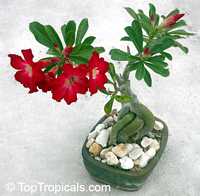
New
article by Jane Jordan.
"...The famous quote is often used to imply that the names
of things do not affect what they really are, in the case
of The Desert Rose (Adenium obesum) it is not a rose at
all, rather a succulent that thrives in hot, dry and sunny
conditions. These spectacular plants have no relation to
the rose family, they are a species of flowering plant
from the dogbane family, Apocynaceae. The naming of this
plant is partly correct as they originate in sub-Saharan
Africa and the Arabian Peninsula, where they can grow into
large trees with huge swollen trunks..."
Continue reading...
Date:
Tip of the Month: dealing with heat waves
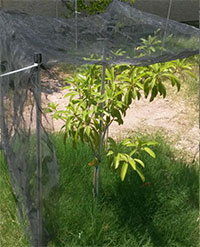
Q: I live in California and this summer has been super hot, with temperature above 100 degrees. This heat wave is killing my plants! Please help!
A: If
you live in Southwest, then you are familiar with heat
waves, when temperature raises above 110F and up to 120F,
while humidity is below 10%. Scorching heat can damage and
kill unprotected young plants. Especially if they're
recently planted.
Most tropical plants came from humid tropics and they
don't easily tolerate high temperatures and low humidity.
You can tell such plants immediately. Desert plants have
small, waxy succulent leaves, which are capable to reduce
evaporation. (See list of plants tolerant to hot
and dry conditions). Tropical plants have large soft
leaves and need high humidity.
These steps will help to protect them... Continue reading...
